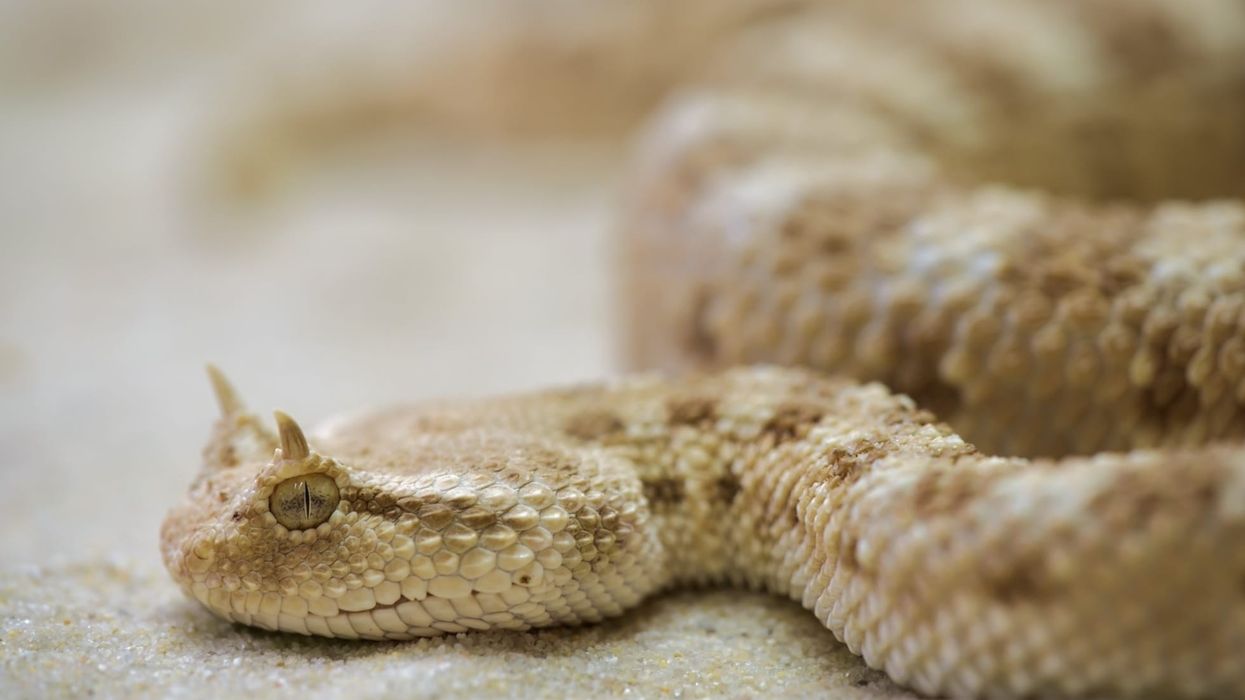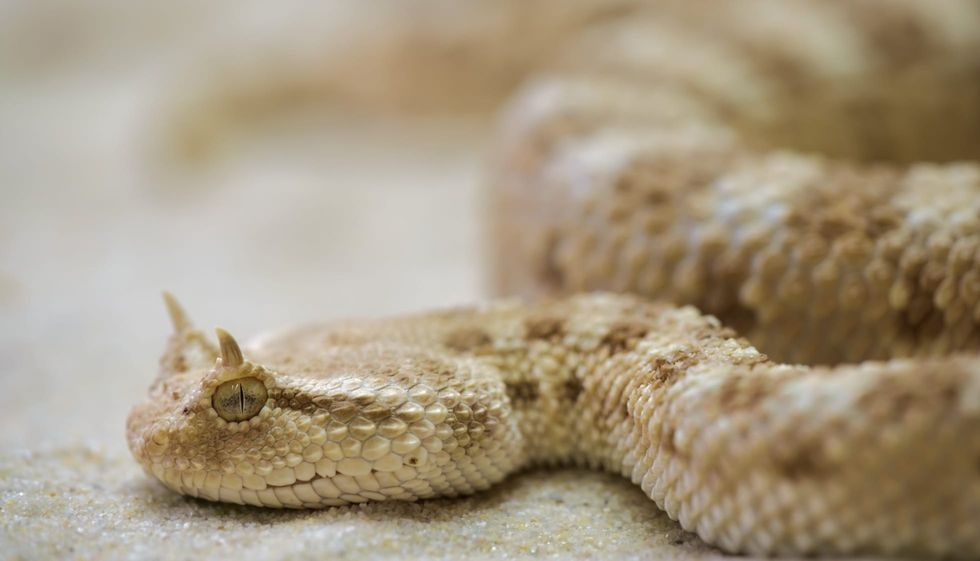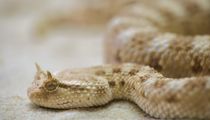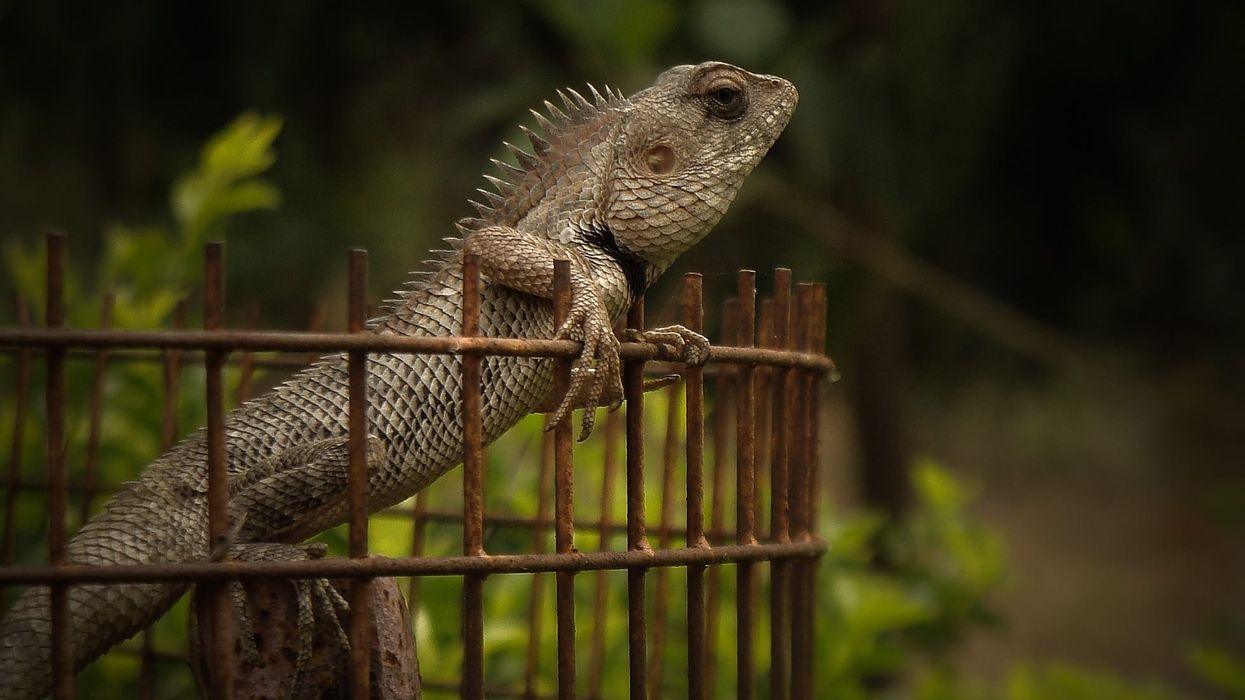Fun Horned Snake Facts For Kids

Horned snakes or vipers are a species of snakes that are endemic to the Sahara deserts in the North African regions and a large part of the Middle Eastern regions.
These vipers are known for their horn-like scales that grow on their eyes which protect the eyes from the sand as these vipers bury themselves under it and wait for prey to come to them.
The horned viper lives at an altitude of 3000ft (1500 m) and is a non-aggressive species and will not attack unprovoked. In many Middle Eastern regions, they are seen as harmless and are a natural control of the rodent population.
These vipers are venomous and a bite from them will cause immense pain and health issues that might become severe if not treated as soon as possible. Since these vipers do not have many natural predators, they are abundant in parts of the Saharan regions and will not be close to being endangered any time soon.
If you liked these true facts about horned snakes, then you'll surely like these facts about the worm snake and sunbeam snake too!
Horned Snake Interesting Facts
What type of animal is a horned snake?
Horned snakes are dangerous snakes from Africa and the Middle East. This species of snakes belong to the Cerastes genus and are further divided into three species which include the desert horned viper or desert viper (C. cerastes), Arabian horned viper (C. gasperettii), and the Sahara sand viper (C. vipera).
They are one of the unique snake species that have a horn on their head, from which the name of the species comes.
What class of animal does a horned snake belong to?
Horned snakes (cerastes) belong to the class Reptilia; reptiles are tetrapod vertebrates, i.e., creatures that have either four limbs or, like snakes, have four-limbed ancestors.
How many horned snakes are there in the world?
An accurate count of the population of these snakes is tough to state as these snakes are found in abundance in their natural habitats in the Arabian peninsula and North Africa regions with none of the species of desert viper, Arabian horned viper, or the sand viper being close to endangerment or extinction.
Where does a horned snake live?
Horned snakes are native to North Africa and the Middle East and occur naturally in desert habitats. They are abundantly found in the Sahara desert in North Africa in parts of Egypt and Morocco and in the Arabian peninsula in the Middle East occurring in Yemen, Saudi Arabia, Kuwait, Iran, and Qatar.
The Sahara horned viper is the most commonly found species of horned vipers.
What is a horned snake's habitat?
Horned snakes prefer to live in environments that have cooler desert temperatures and are often found resting in rodent burrows. They prefer the desert sand as the color pattern of their scales matches with the sand around them making their presence unknown and thus helping the individuals to camouflage themselves from the eye of the common predators.
They also favor a dry area with lots of sand that are spread within sparse rock outcroppings and will usually avoid coarse sand.
Who do horned snakes live with?
The Sahara horned snakes (Cerastes cerastes) are solitary in nature and prefer to live alone and hide their presence as well as they can. During the day they hide in burrows made by other animals, under rocks and woods scattered in the deserts.
They do, however, come together during the mating season. It is unknown whether the individuals stay together after breeding or go on their own ways.
How long does a horned snake live?
The lifespan of these desert native snakes is unknown in the wild. In captivity, they have been recorded to have lived for around 14-18 years.
How do they reproduce?
Horned vipers sexually mature when they are two or three years of age and will come together during the mating period which lasts from April to June, with the males or the females releasing pheromones to attract a potential mate.
Once the pair is together, they will mate in the sand and might copulate for a maximum of four days as seen by their mating behavior in captivity.
The female horned viper will lay up to 23 soft-shelled eggs in abandoned burrows or under the rocks after a gestation period of 50-80 days with the incubation period usually lasting six to eight weeks before the eggs hatch.
What is their conservation status?
Horned vipers, even with a loss of habitat due to human interaction, are common in the deserts and dry land habitat and are safe.
All three subspecies of the horned viper, the Sahara horned viper (C. cerastes), the Arabian horned viper, or the desert horned viper (C. gasperettii), and the Sahara sand viper (C. vipera) are listed as of Least Concern by the IUCN Red List.
The survival rate of the horned viper is immensely high thanks to their body scale that resemble the sand around them, helping them camouflage and hide from predatory animals, which are only a handful of animals.
Horned Snake Fun Facts
What do horned snakes look like?
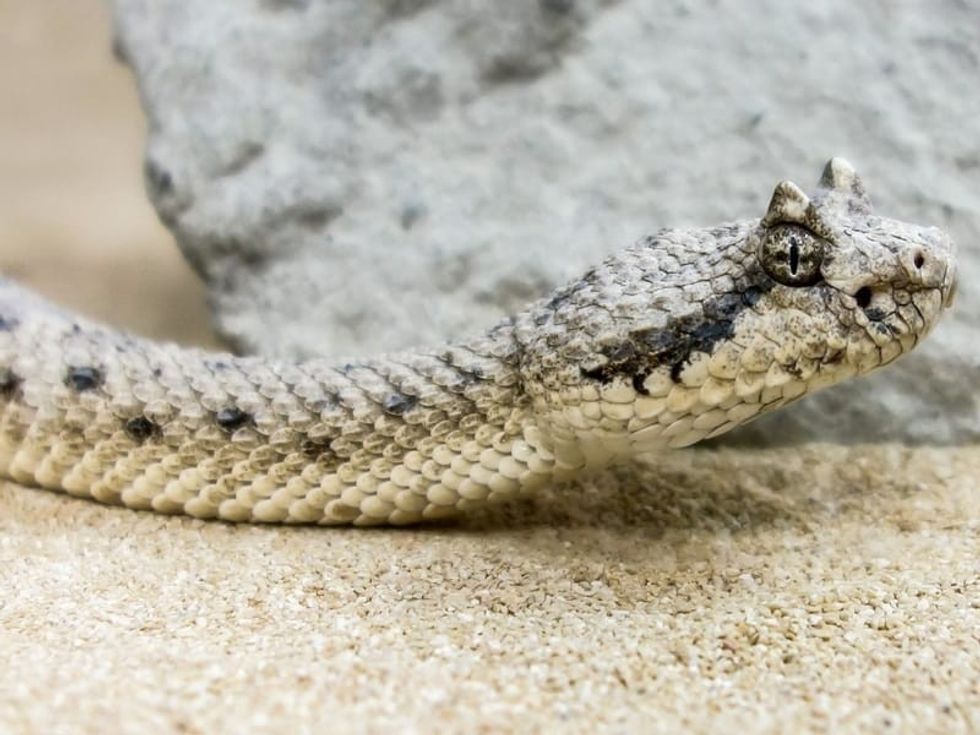
The horned desert viper, also known as North African horned viper (Cerastes cerastes), are known for their distinctive 'horns' that are present above each eye. These vipers are small and stout and have a broad, triangular head with slitted retinas.
Compared to the Arabian horned viper (C. gasperettii), the desert horned viper (C. Cerastes) are larger and have a great number of horned individuals.
Horned individuals might or might occur in the same species or litters. The Sahara viper (Cerastes vipera) is the naturally occurring Cerastes species that do not have horns on their eyes.
These snakes come in a color pattern of pale gray, pinkish, pale brown, reddish, or yellowish which helps them camouflage with their surroundings.
They have a dark, semi-rectangular design that resembles blotches running through the length of their bodies and may or may not be fused with the crossbars. They have a white underbelly and the tail is short and thin which might have a black tip.
They have small dorsal scales which are keeled in 23-55 rows at the midbody.
Horned vipers (C. cerastes) that live in sandy deserts are more likely to have horns in comparison to those that live in stony deserts as one speculated use of the horns on their head is to help them protect their eyes from the sand in the surroundings and since they play a waiting game as ambush predators, it is easier for them to keep their eyes just above the sand with their body underground with the horns helping them in breaking the line of sight of the prey by hiding parts of their body in the sandy environments.
How cute are they?
Horned vipers, with their small body length and a thin short tail, do look cute! However, the horns on the head of these vipers also make them look fierce. So, after taking a good look at their photos, it will not be far-fetched to call them both cute and fierce!
How do they communicate?
Members of the Cerastes genus usually exhibit predatory launch strikes from inside the Saharan sands from a buried position, due to this camouflage behavior, communication, and perception in these horned vipers use environmental stimulation to locate prey. The horned viper uses vibrations as a mode to detect its surroundings and move accordingly.
Visual capabilities are also used in strike accuracy and distance.
Horned vipers, when communicating with the same species, will rely upon chemical signals by releasing pheromones, which can be used to attract mates or warn other trespassing snakes. These ambush predators can also sense body heat from other organisms using their pit organs to prey on them or fend them off.
These pit organs are located just behind the nostrils of the horned viper and allow them to detect animals with warm blood in the dark.
How big is a horned snake?
The horned viper has different body lengths for each species with the C. vipera being the smallest of the species with a body length of 7.8-13.7 in (20-35 cm) and the largest being the horned desert viper (Cerastes cerastes) and the desert horned viper (Cerastes gasperettii) with an average body length of 11.8-23.6 in (30-60 cm) and a maximum length of 33.4 in (85 cm).
How fast can a horned snake move?
Due to a lack of sufficient data the speed at which these North African and Middle Eastern snakes move cannot be stated.
How much does a horned snake weigh?
The weight of these vipers is tough to state as there is not much data to go around to pinpoint their exact weight. However, they can grow up to 1.1 lb (500g)
What are the male and female names of the species?
No particular name has been assigned to either sex of the horned viper.
What would you call a baby horned snake?
A baby horned viper, like most other snake babies, is called a snakelet. Snakelets are born live and will stay with their mothers until they are big enough to wander alone.
What do they eat?
Horned snakes are carnivores and mainly feed on smaller animals like rodents, birds, geckos, and lizards. Due to this, they are often seen as nature's pest control and are left unbothered by humans.
Are they poisonous?
The horned viper is not poisonous, but it is venomous.
The horned viper has 13 different types of toxins in its fangs that are located at the back of its mount. Horned snake venom can have a lasting effect on the human skin, which is not usually fatal, but can cause serious concerns.
A bite from a horned viper can use swelling, blood coagulation, kidney failure, acute renal failure, hemolysis, nausea, sweating, and heart irregularities, and many other issues in the human body, and in most cases, cannot kill a human being.
Would they make a good pet?
No! A horned viper as a pet is a bad idea as these vipers have not been domesticated and will not survive in a domestic environment. These vipers prefer the vast North African deserts and desert regions of Saudi Arabia and other Middle Eastern countries.
Did you know...
The Matilda's horned viper (Atheris matildae), despite its name, is a bush viper species found in Tanzania in a low population and is critically endangered.
The horned viper is part of ancient mythology and folklore as it is said that the Egyptian queen, Cleopatra, used a horned viper to commit suicide.
Since the horned viper has a limited set of predators, they greatly help in the population control of rodents in the areas they live in.
Horned vipers rest the entire day and come out of hiding to hunt at night as they are nocturnal animals.
Besides the three species of horned viper under the Cerastes genus, there are other horned viper species like the field's horned viper (found in the Middle East), Persian horned viper (found in the Middle Eastern regions and Asia), and the spider-tailed horned viper (Found in Western Iran) that fall under the Pseudocerastes genus.
The desert horned viper (C. Cerastes) is the least aggressive viper of the Cerastes species and will show no signs of aggression when approached.
Some other vipers to check out include the spiny bush viper and Russell's viper.
Are horned vipers aggressive?
The horned viper (Cerastes cerastes, Cerastes gasperettii, Cerastes vipera) species is usually a non-aggressive species and will not attack unprovoked. They will however show signs of aggression by hissing loudly and will curl up their body as to not leave any openings and inflate their bodies to look bigger.
What eats the horned viper?
Horned vipers (Cerastes cerastes, Cerastes gasperettii, Cerastes vipera) have a few natural predators that prey on them. Some of these predators are honey badgers, monitors, wild and feral cats. Other than these selected few, not many will try to attack or eat the horned viper.
Here at Kidadl, we have carefully created lots of interesting family-friendly animal facts for everyone to discover! For more relatable content, check out these sea snake facts and rubber boa facts for kids.
You can even occupy yourself at home by coloring in one of our free printable horned snake coloring pages.
We Want Your Photos!
More for You
Bachelor of Arts specializing in Journalism and Mass Communication, Postgraduate Diploma in Sports Management

Moumita DuttaBachelor of Arts specializing in Journalism and Mass Communication, Postgraduate Diploma in Sports Management
A content writer and editor with a passion for sports, Moumita has honed her skills in producing compelling match reports and stories about sporting heroes. She holds a degree in Journalism and Mass Communication from the Indian Institute of Social Welfare and Business Management, Calcutta University, alongside a postgraduate diploma in Sports Management.
Bachelor of Arts specializing in Economics

Gowri RaoBachelor of Arts specializing in Economics
With a bachelor's degree in Economics from Krea University, Gowri is a highly skilled data analyst and an expert in regression and causation modeling. Her interests in economic trends, finance, and investment research complement her professional expertise. In addition to her professional pursuits, Gowri enjoys swimming, running, and playing the drums, and she is also a talented tutor.
Disclaimer
1) Kidadl is independent and to make our service free to you the reader we are supported by advertising. We hope you love our recommendations for products and services! What we suggest is selected independently by the Kidadl team. If you purchase using the Buy Now button we may earn a small commission. This does not influence our choices. Prices are correct and items are available at the time the article was published but we cannot guarantee that on the time of reading. Please note that Kidadl is a participant in the Amazon Services LLC Associates Program, an affiliate advertising program designed to provide a means for sites to earn advertising fees by advertising and linking to Amazon. We also link to other websites, but are not responsible for their content.
2) At Kidadl, we strive to recommend the very best activities and events. We will always aim to give you accurate information at the date of publication - however, information does change, so it’s important you do your own research, double-check and make the decision that is right for your family. We recognise that not all activities and ideas are appropriate for all children and families or in all circumstances. Our recommended activities are based on age but these are a guide. We recommend that these ideas are used as inspiration, that ideas are undertaken with appropriate adult supervision, and that each adult uses their own discretion and knowledge of their children to consider the safety and suitability. Kidadl cannot accept liability for the execution of these ideas, and parental supervision is advised at all times, as safety is paramount. Anyone using the information provided by Kidadl does so at their own risk and we can not accept liability if things go wrong.
3) Because we are an educational resource, we have quotes and facts about a range of historical and modern figures. We do not endorse the actions of or rhetoric of all the people included in these collections, but we think they are important for growing minds to learn about under the guidance of parents or guardians.
